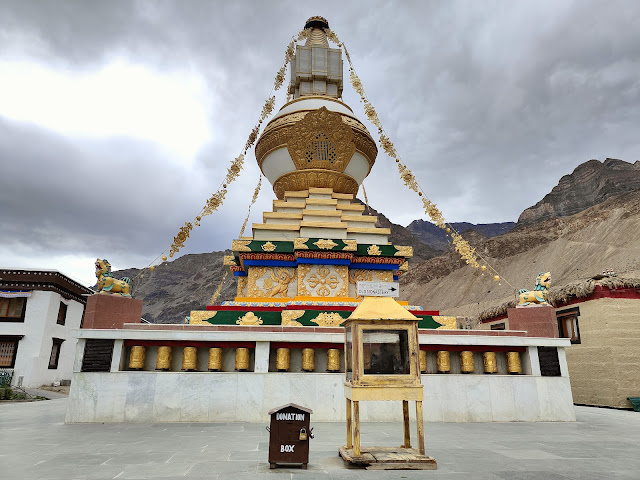Himachal Diaries: Part Nine
Day Six (06.07.2024): Exploring Tabo
Tabo village is a small picturesque town often called the "Ajanta of the Himalayas". Surrounded by snow-capped mountains and the Spiti river, Tabo offers stunning natural beauty. It's a tranquil retreat for those seeking peace and quiet. We started walking towards the monastery at 4pm. It was a 15 minutes walk through the narrow lanes of the village. We passed through a big prayer wheel and a series of small prayer wheels. Munjya stories were on between Avadhut and Chinmay.
Tabo Chos-hkhor, 1000-year-old monastery, is a treasure trove of ancient murals, scriptures, and artifacts and situated at an elevation of 10010ft above the sea level. Hrishikesh briefed on the monastery. It has nine temples, four decorated stupas, and cave shrines.
The main temple has an entry hall (Go Khang), followed by an Assembly Hall (Du Khang). At the western end of the assembly hall there is an apse, which has a cella or shrine area (Ti Tsang Khang) with an ambulatory (Kor lam Khang) passage. The Vajradhatu mandala is seen in the New Assembly Hall after entering from the old entry hall where the main deity of Vajradhatu, Vairocana (height 110 cm), is shown seated on a single lotus throne on the back wall. The mandala also has 32 life-size clay sculptures of other deities which are embedded to the wall which merge well within the painted environment. The main temple (Tsug la Khang) contains many scriptures written on wooden planks, which are hung on the walls. It is lit by a small sky window and hence the room appears dark.
The Golden Temple (gSer-khang) is said to have been once covered with gold. The walls and ceilings are covered with magnificent murals, which are well preserved and are dated to the 16th century.
The Bodhisattva Maitreya Temple (Byams-Pa Chen-po Lha-khang) is an ancient temple built in the first 100 years of the main monastery as testified by the wooden door frame. The image of the Bodhisattva Maitreya here is over 20 feet high.
The Temple of Dromton (Brom-ston Lha khang) has murals of the eight Medicine Buddhas, which are dated to the 17th century; at the base of this temple the life of Shakyamuni Buddha is painted in a narrative form.
We were not allowed photography inside any of the temples. Done with the old monastery, we proceeded to the new monastery but it was closed.
There were souvenir shops selling fridge magnets, prayer wheels, prayer bowls, flags, keychains, postcards, etc. Some went shopping in the Tabo market.
We were back to the hotel by 5:15pm and I was convincing my group for the caves trek. But no one agreed. We went to our rooms and had to come down for tea break in half an hour. I really wanted to see the caves. More on this in the next post.
Read next: Himachal Diaries: Part Ten



















